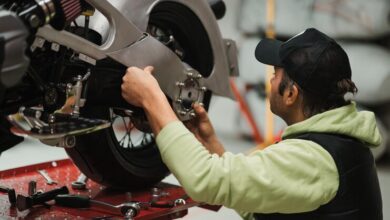How Can You Tell If That Vibration Is a Tire or Suspension Issue?

Your car should glide down the road smoothly. So when it starts to vibrate, it’s not just uncomfortable—it’s a sign that something isn’t quite right. Whether it’s a shaking steering wheel or a rattling seat, knowing the root cause can save you time, money, and prevent further damage. If you’re trying to figure out whether the issue lies with your tires or suspension, visiting a trusted tire shop Nashville locals rely on is often the first step to getting accurate answers and solutions.
One of the most common questions drivers ask is: “Is this vibration coming from my tires or is it a suspension problem?” In this article, we’ll break down how to tell the difference, what signs to look for, and when it’s time to call in the pros.
Common Causes of Car Vibrations
Before we zoom in on tires and suspension, it’s helpful to understand that car vibrations can come from a range of sources. These include:
- Imbalanced or damaged tires
- Misaligned wheels
- Worn-out suspension components
- Warped brake rotors
- Issues with the driveshaft or axles
Each of these components affects how your car rides, but tires and suspension are two of the most common—and confusing—culprits.
Tire-Related Vibration Symptoms
Tires are the only part of your vehicle that touches the road, so any issue with them is bound to make itself known. Here are the main signs the vibration is tire-related:
Vibrations at Specific Speeds
One telltale sign of tire trouble is vibration that starts at certain speeds—usually between 50–70 mph. If the shaking gets worse the faster you go, it’s often a sign of tire imbalance or alignment problems.
Uneven Tire Wear
Take a look at your tires. Do you notice bald spots, feathering, or cupping? Uneven wear can create vibration and is often caused by poor alignment or unbalanced tires.
Vibration Felt in the Steering Wheel
If you feel the vibration primarily in your steering wheel, especially when driving straight, it’s likely coming from the front tires. This is a classic sign of wheel imbalance or a bent rim.
Read Also: Web Development Services in Pakistan: Smart Solutions for Every Business
Suspension-Related Vibration Symptoms
If your tires check out, it’s time to look at the suspension system. This network of shocks, struts, control arms, and bushings is designed to keep your ride smooth and controlled.
Vibration When Turning or Hitting Bumps
Unlike tire vibrations, suspension issues often appear when cornering or going over uneven terrain. If your car shakes or bounces excessively on a bumpy road, your shocks or struts might be failing.
Unusual Noises
Knocking, clunking, or creaking sounds—especially when turning—are often related to worn suspension components. These noises may come before or along with the vibrations.
Steering and Handling Feel “Off”
Loose or overly sensitive steering, drifting during turns, or an overall unstable feel point to suspension wear. If your car no longer feels planted or predictable, it’s time for a suspension check.
How to Differentiate: Tire vs. Suspension Vibration
Understanding where and how the vibration occurs is key to identifying the source. Here’s how to compare:
Location of the Vibration
- Steering Wheel: Front tire issue or front suspension component
- Seat or Floorboard: Rear tire or rear suspension issue
Speed-Related Behavior
- Starts at a Specific Speed: Most often tire balance or alignment
- Constant Regardless of Speed: May be deeper suspension issue
Visual Inspection
Look for obvious signs like uneven tire wear, sagging suspension corners, or fluid leaks from shocks and struts. These are your first clues.
Diagnosing Tire Problems
Tires can cause vibrations in multiple ways. Thankfully, they’re relatively easy to inspect. Start with the basics:
Check Tire Balance and Alignment
Unbalanced tires are a primary cause of vibration. Have them professionally balanced and ensure your wheels are properly aligned.
Inspect for Damage
Look for sidewall bulges, embedded objects, or flat spots—especially if the car has been parked for a while. Damaged or old tires can create vibration even if they’re balanced.
Rotate Tires Regularly
Rotating your tires every 5,000 to 7,000 miles ensures even wear. Skipping this simple step can accelerate wear and lead to vibration issues.
Diagnosing Suspension Issues
Suspension problems aren’t always as easy to spot, but they often come with visible or tactile warning signs. Here’s how to assess the situation:
Examine Shocks and Struts
Inspect for oil leakage or damage. If the shocks are leaking fluid, they’re no longer doing their job. You can also perform a bounce test: push down on each corner of your car. If it bounces more than 2–3 times, your shocks may be worn out.
Check for Sagging Corners
A noticeably lower corner of the vehicle can indicate a broken spring or failed strut. This not only causes vibration but also affects alignment and tire wear.
Inspect Bushings and Joints
Worn or cracked bushings can allow excess play in your suspension system, causing instability and vibration. These are best checked on a lift or during a professional inspection.
When to Seek Professional Help
Not every vibration can be diagnosed in your driveway. If the cause isn’t obvious or if multiple issues seem to be happening at once, it’s time to visit a certified mechanic.
A professional can use diagnostic equipment like a road force balancer or suspension tester to pinpoint the exact issue. Delaying repairs could cause further damage to wheels, bearings, or axles—and make your ride downright dangerous.
Preventing Future Vibration Issues
Routine maintenance is the easiest way to keep your car vibration-free. Here are two key habits that make a difference:
- Tire Care: Balance, rotate, and inspect your tires regularly. Replace them when worn out, and don’t skip alignment after repairs.
- Suspension Inspections: Include suspension checks during oil changes or seasonal service visits. Look for early signs of wear to avoid expensive repairs later.
Also, avoid hitting curbs or potholes, which can throw both tires and suspension out of alignment quickly.
Conclusion
Vibrations while driving aren’t something to ignore. The most common causes boil down to either your tires or your suspension—and knowing the difference can help you fix the problem faster.
If your steering wheel shakes at speed, it’s likely a tire issue. If the car vibrates over bumps or feels loose in turns, you’re probably dealing with worn suspension components.
By paying attention to where and when the vibrations happen and visiting a professional tire shop Nashville trusts, you can get a proper diagnosis and keep your vehicle running safely and smoothly. Don’t let a small shake turn into a big problem—act early and enjoy a smoother ride.



